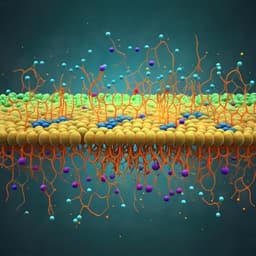
Engineering and Technology
3D printed N-doped CoCrFeNi high entropy alloy with more than doubled corrosion resistance in dilute sulphuric acid
R. Zhou, W. Chen, et al.
Discover how selective laser melting (SLM) has enabled the production of a groundbreaking N-doped CoCrFeNi high-entropy alloy with exceptional corrosion resistance—over twice that of traditional samples. This innovative research, conducted by Rui Zhou, Wenyu Chen, Wanpeng Li, Tzu-Hsiu Chou, Yen-Hsiang Chen, Xiaopeng Liang, Junhua Luan, Yuntian Zhu, J. C. Huang, and Yong Liu, is a game-changer in materials science.
~3 min • Beginner • English
Introduction
Marine machinery and engine components rely on steels or Ni-based materials with high strength and excellent corrosion resistance due to humid, electrolytic service environments. Achieving both high strength and corrosion resistance simultaneously is challenging: single-phase alloys often have low strength, while introducing second phases or precipitates increases strength but can cause galvanic corrosion; thermomechanical processing increases strength but the resultant high density of grain boundaries can promote intergranular corrosion. Conventional ingot casting and thermomechanical microstructure engineering struggle to overcome this dilemma. Selective laser melting (SLM) can create hierarchically heterogeneous microstructures in austenitic steels, potentially enhancing strength, work hardening, ductility, and possibly corrosion resistance due to submicron dislocation walls. High-entropy alloys (HEAs) based on multi-principal elements can form single-phase solid solutions stabilized by configurational entropy, and enrichment of anti-corrosion elements (e.g., Cr) can provide corrosion resistance. Prior studies have examined corrosion behavior of FeCoCrNi-based HEAs fabricated by various routes (melting, rolling, laser cladding, SLM, DED), with better corrosion resistance in SLM-processed CoCrFeMnNi in 3.5 wt% NaCl attributed to compositional homogeneity and grain refinement. In this work, the authors demonstrate that SLM can produce single-phase N-doped CoCrFeNi HEA samples with exceptional strength-ductility and excellent corrosion resistance in acidic environments. The SLM-produced sample exhibits more than twice the corrosion resistance of a hot isostatic pressed (HIP) counterpart of the same composition, as measured by corrosion current density.
Literature Review
The study builds on literature highlighting the trade-off between mechanical strength and corrosion resistance in alloys and the potential of SLM to create beneficial heterogeneous microstructures. Previous investigations of FeCoCrNi-based and CoCrFeMnNi HEAs across fabrication methods (melting, rolling, laser cladding, SLM, and DED) reported corrosion behavior in chloride-containing environments, with SLM-improved corrosion resistance linked to compositional homogeneity and grain refinement. The role of microstructural defects (dislocations, grain boundaries) in passivation, and semiconducting behavior of passive films (p–n heterojunctions) on Fe–Cr and Ni-based alloys and HEAs have been documented. Nitrogen alloying has been reported to influence passive film semiconductivity and defect densities, generally enhancing corrosion resistance by lowering defect concentrations. The importance of Cr enrichment and the stability of Cr2O3 relative to Cr(OH)3 in passive films is well-established, with higher Cr2O3 fractions correlating with better passivity. These insights frame the current study’s focus on SLM-induced dislocation cell structures promoting rapid passivation and robust passive film formation in acidic media.
Methodology
Materials processing: Pre-alloyed CoCrFeNiN0.07 powders were produced by gas atomization under nitrogen (achieving N doping), spherical, 2–100 µm, mean size ~18 µm. Three processing routes were used: (i) Selective Laser Melting (SLM) on an FS271M (Farsoon, China), laser power 400 W, scan speed 1200 mm s−1, beam size ~120 µm, hatch spacing ~100 µm, layer thickness ~30 µm, nitrogen atmosphere; scan rotation 67° between layers; printed samples annealed at 673 K for 3 h and water-quenched. (ii) Hot Isostatic Pressing (HIP): powders sealed in stainless steel can (Φ 75 mm × 200 mm), degassed at 673 K for 10 h, consolidated at 1523 K, 140 MPa, 2 h, then furnace-cooled. (iii) HIP followed by Cold Rolling (CR): sheets sectioned from HIP billet, thickness reduced from 10 mm to 2 mm (80% reduction) by multiple passes. Densities measured by Archimedes method: SLM 8.098 ± 0.031, HIP 8.113 ± 0.087, CR 8.116 ± 0.040 g cm−3.
Microstructure characterization: Phase identification by XRD (Rigaku Smartlab, Cu Kα, 2θ = 20–100°). Surface corrosion morphologies by SEM (FEI Quanta 450 FEG). Grain structures and textures by EBSD-equipped SEM. Passive film cross-sections prepared by FIB (FEI Scios). APT specimens prepared by FIB lift-out and annular milling; analyzed on CAMECA LEAP 5000 XR at 70 K in voltage mode with detection rate 0.2% atoms/pulse. TEM (JEOL 2100F and FEI Talos F200X, 200 kV) used for BF/DF imaging and SAED. For passive film composition, specimens passivated 3 h in 0.5 M H2SO4 at 0.7 V (within passive region), analyzed by XPS (PHI 5802, Al Kα 1486.6 eV); peaks calibrated to C 1s at 284.8 eV; Shirley background subtraction.
Electrochemical testing: Conducted in 0.5 M H2SO4 at room temperature on CHI 670E workstation using a three-electrode cell (HEA working electrode, exposed area 1.0 cm2; Pt counter; Ag/AgCl reference). Specimens were ground to 2000 grit and diamond polished. OCP recorded for 2 h to steady state. EIS at OCP from 100 kHz to 10 mHz with 10 mV AC amplitude; data fitted with an equivalent circuit containing solution resistance (Rs), passive film capacitance (Qf, CPE), passive film resistance (Rf), charge transfer resistance (Rct), and double-layer capacitance (Qdl, CPE). Potentiodynamic polarization (PDP) from −0.4 V to 1.5 V at 0.5 mV s−1. Mott–Schottky measurements from −0.3 to 0.9 V (vs Ag/AgCl) at 1 kHz with 5 mV AC, 10 mV step. All electrochemical tests repeated at least three times.
Key Findings
- Microstructure: SLM produced a heterogeneous layer structure with alternating fine- and coarse-grained bands (~30 µm and ~70 µm width, average grain sizes ~18 µm and ~52 µm). A single FCC phase was confirmed for all samples (SLM, HIP, CR). SLM generated high-density 3D dislocation cell structures (~500 nm) within grains; APT indicated nanoscale uniform elemental distributions (solid solution).
- Mechanical context: HIP yielded low yield strength and high ductility; CR increased strength but reduced elongation (~6%); SLM showed hierarchically heterogeneous structures enabling a good strength–ductility combination.
- Corrosion performance in 0.5 M H2SO4: All samples exhibited broad passive regions. The passive current density i_p was lowest for SLM (6.1 A cm−2) compared to HIP (13.8 A cm−2) and CR (19.6 A cm−2). Using 1/i_p as a proxy for corrosion resistance, SLM was >2× that of HIP and >3× that of CR.
- EIS: SLM showed the largest Nyquist semicircle, indicating superior passivity; Bode plots displayed stable passive films (phase ~−80°) across samples, with SLM having the highest |Z| at 0.1 Hz. Equivalent circuit fitting showed SLM with higher Rf and Rct than HIP and CR, denoting stronger protective passive films.
- Passive film thickness and semiconductivity: Cross-sectional TEM revealed thicker passive films for SLM (~9.37 nm) versus HIP (~5.65 nm) and CR (~5.24 nm). Mott–Schottky analysis showed p–n heterojunction behavior. Donor (ND) and acceptor (NA) densities were lowest for SLM (ND ~8, NA ~7) compared to HIP (ND ~17, NA ~10) and CR (ND ~20, NA ~12), indicating fewer point defects and more compact films.
- Passive film chemistry: XPS indicated Cr enrichment in all passive films with higher Cr at.% at the outermost surface for SLM (Cr ~65%, Fe ~15%, Ni ~10%, Co ~10) relative to HIP (Cr ~60%, Fe ~18%, Ni ~10%, Co ~12) and CR (Cr ~55%, Fe ~20%, Ni ~10%, Co ~15). The fraction of Cr2O3 in the passive film was highest in SLM (~40%) versus HIP (~30%) and CR (~25%), favoring superior passivity.
- Microstructural mechanism: STEM/EDS showed ~3 at.% Cr segregation along dislocation cell boundaries compared to interiors, providing abundant oxide nucleation sites and promoting rapid passivation. SLM samples exhibited corrosion localized along cell boundaries without pronounced intergranular corrosion, unlike HIP and CR which showed severe intergranular attack.
Discussion
The study addresses the long-standing strength–corrosion resistance trade-off by leveraging SLM-induced 3D dislocation cell structures in a N-doped CoCrFeNi HEA. The high density of dislocations and the nanoscale cell boundaries act as abundant nucleation sites for oxide formation and as 3D fast diffusion networks that accelerate outward cation transport, particularly Cr. This enhances the kinetics of passive film nucleation and growth, leading to a thicker, more compact, and less defective Cr-rich passive film with a higher Cr2O3/Cr(OH)3 ratio. Electrochemical results (lower i_p, higher |Z| at low frequency, larger Nyquist semicircles, higher Rf and Rct) corroborate the superior protective quality of the SLM passive film. The localized nanoscale Cr segregation fosters micro-galvanic coupling that accelerates internal passivation within cells while avoiding detrimental macro-scale galvanic effects. Consequently, SLM enables rapid, robust passivation in acidic solution without introducing intergranular corrosion susceptibility, thereby maintaining mechanical benefits from the hierarchical microstructure while enhancing corrosion resistance.
Conclusion
Selective laser melting of N-doped CoCrFeNi high-entropy alloy produces a single-phase FCC material with hierarchical microstructures featuring 3D dislocation cell networks that more than double corrosion resistance in 0.5 M H2SO4 relative to HIP, and exceed CR performance by over threefold. The improvements stem from rapid passivation enabled by numerous oxide nucleation sites and accelerated outward diffusion of Cr along cell boundaries, forming thicker, Cr2O3-rich passive films with fewer point defects. This approach mitigates the typical trade-off between strength and corrosion resistance. The strategy is likely applicable to other single-phase HEAs containing anti-corrosion elements to resist acid attack while achieving mechanical strengthening.
Limitations
Related Publications
Explore these studies to deepen your understanding of the subject.







